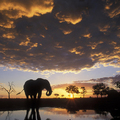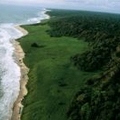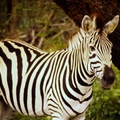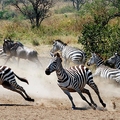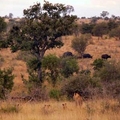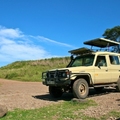Destinations / The Best Places for a Safari in Africa / Kruger National Park, South Africa
Kruger National Park, South Africa
Kruger National Park in South Africa has the greatest diversity of wildlife in Africa, including the 'big five', hippos, crocodiles, leopards and others. Kruger Park in terms of arrangement and support is the best in Africa, so ideal for an independent safari on your own machine. Kruger National Park is 2 million hectares protected African savannah, where an incredible variety of life forms exist in harmony in a frame of archaeological and historical monuments. The park stretches for 350 km from the north to the south and 60 km from the east to the west, covering the land of the South African provinces of Mpumalanga and Limpopo . Currently, it is part of the Cross-Border Park Great Limpopo Park, Kruger Park, which connects the north with the National Park in Zimbabwe and to the east of Limpopo National Park in Mozambique. Each year, the Park has more than half a million tourists. Kruger National Park is the "flagship" of the South African reserves , representing an impressive diversity of plant and animal life - it's 336 species of trees, 49 species of fish, 34 - amphibians, 114 - reptiles, 507 species of birds and 147 species of mammals. There is also a buffer zone International Man and Biosphere Reserve, protected by UNESCO as a place of the most harmonious relationship between man and nature, which are perpetuated in the Bushman rock art and unique archaeological sites, such as Masorini and Thulamela. These treasures represent the people, the culture and the events that played an important role in the history of the park and the country.
Kruger National Park has its calendar of 1898 , when at the urging of President Paul Kruger the area between the rivers and the Sabie Crocodile River were taken under the state protection in order to make the animals survive, because their population has decreased due to the uncontrolled critical hunting. In 1902. James Stevenson-Hamilton was appointed the first superintendent of the reserve - his name was put to Memorial Library Park, where you can find many interesting evidence about the early days of this amazing place. The park was first opened to the public in 2002 and marked the association with the Kruger Park National Parks of Mozambique and Zimbabwe and the formation of Transboundary Park Great Limpopo. The park is located in the subtropical zone, humid and hot in summer, when the thermometer rises above 38 ° C and winters are dry and warm. The rainy season lasts from September to May. The best time to visit the park is in winter as the grass is low and the bushes and the trees do not have the lush crowns of leaves that do not obstruct the view. Due to the lack of rain the animals come to the watering in the morning and in the evening and they can be easily seen even from the car. In addition, during this period the risk of contracting malaria is reduced. Of course, the main attraction of the Park is its rich flora and fauna. Its 3000 hippos and crocodiles as much living in the rivers, the water which does not dry all the year round. On land, the most common animals are antelopes - more than 90,000 copies, 30 000 15 000 zebras and bison create turmoil in the vast expanses of savannah, 5000 giraffes, 8000 elephants, rhinos and 300 make up their company. Predatory cats, lions, 1500, 900 leopards and 300 cheetahs are also an integral part of a unique ecosystem. In the "small five" are leopard tortoise, rhinoceros beetle, the shrew, ant lion and buffalo weaver bird. Ornithologists will be interested in hornbills, bustards, vultures, eagles, owls, storks, and fishermen. In the plant kingdom's most famous and impressive species are the giant baobabs. The cultural heritage of the Park is no less diverse – there are 254 archaeological sites, including parking areas of prehistoric man (100 000-500 000 years ago), the artifacts of the Stone Age (30,000 - 100,000 years ago) and Iron Ages (about 1500 years ago). The most interesting man-made monuments should include the Museum of Elephants, Jock of the Bushveld Route, Albasini Ruins (trading station, built in the XIX century, the famous Portuguese businessman Joao Albasini), Maserini Ruins (within the settlement period, Iron Age), Stevenson Hamilton Memorial Library and Thulamela (the settlement from the Iron Age which culture dates back to the civilization of the kingdom of the famous Mapungubwe).
Yet, museums and ancient sites are only a supplement that attracts thousands of tourists from around the world - an amazing and mysterious wilderness of Africa. Touch it for a couple of hours or be a part of for a few days will help you:
• morning safari in the 10 - and 20-seat off-roader with the administration in the summer of 4.30 and 5.30 in winter (or a shorter two-hour from the departure at 9:00), 3-4-hour safari at sunset with departing at 16.00 (or night with a 2-hour administration 2 hours after the closure of the park - only available in some camps). The cost of morning and evening safaris -115 rand, at night - 100. All safaris are led by experienced guides;
• 2-4-hour walking safaris led by specially trained guides in small arms in groups of up to 8 people. Here you can trace the movement of the lion, rhino and elephant. From time to time halts are made to admire the pristine beauty of the savannah. Children under 12 are not allowed.
• "Safari in the desert" - hiking group up to 8 people in the area of pristine park under the protection of armed and well trained rangers who protect and open up the wonders of wildlife in Africa to the uninitiated. The duration is of 4 days and 3 nights. Overnight in 2-seater cabins. There is soul and appliances to prepare food;
• "Safari 4x4" - for special off-road travel, which causes minimal damage to nature. Special routes are designed to ensure that as close as possible to acquaint visitors with different parts of the Park and its unforgettable flora. The park has a limit - a total of 6 cars a day, so you need to book these tours in advance. The cost is about 460 rand per car, regardless of the number of people. There are 12 main camps with different types of accommodation, from the places for caravans and tents with a kitchen and showers to the bungalows, cottages and even luxurious hunting lodges with multiple rooms and every convenience. Some camps have swimming pools and golf. If you are traveling through the park itself, the movement is allowed from dawn to dusk. After dark you need to stay in one of the camps. The number of vehicles entering the territory of the park every day is limited, so if the threshold is exceeded, the park will receive only visitors with pre-ordered tours. Visitors to the park must pay a fee ("conservation fee") for each day spent in the reserves. Remember that animals such as snakes, bats, scorpions, spiders, rats , mice and various insects are an integral part of the Kruger Park ecosystem , and may be in the camp, attracted by electric light, and smells of food that tourists often bring with them and leave around. So if you need somewhere to go at night do not do it without a flashlight. If you snuck into your apartment a bat, cover it with a towel and carry up the street, or call your staff. Monkeys, baboons and tame antelope are happy to go to the people, but remember that feeding them, you are signing their death sentence, because over the time they become totally dependent on this source of food and aggressive forcing them to destroy.
Kruger National Park is the oldest and the most famous reserve in South Africa, one of the largest national parks in the world. In addition to the Pilanesberg and Table Mountain, this is the most visited by tourists National Park in South Africa. Kruger National Park, together with the National Park Gonarezhou in Zimbabwe and the National Park,Limpopo in Mozambique is part of an international fleet of Great Limpopo Transfrontier Park , one of the "Peace Parks" . This means that in this park doesn’t have any protected borders, nothing prevents the free movement of animals. It is planned that the total area of Limpopo Transfrontier Park Great is now at the stage of formation of about one hundred thousand square kilometers.
Maps of Kruger National Park, South Africa
map South AfricaOthers from The Best Places for a Safari in Africa
If you are looking for the best safari where you are almost guaranteed to see the "big five" most popular animals (big five most popular types of animals: lions, leopards, buffaloes, rhinos and elephants), then you cannot be wrong if you choose these places.
If you plan to go on a safari in Africa, we know that there are many aspects that you need to take note: for example, what animals you want to look at, what is the best time to go and do, what type of safari you prefer with all the amenities , camping, traveling, economy-camp - there are plenty to choose from.
The first thing you need to decide on what animal you want to watch.
Mammals, birds, reptiles or The Big Five most popular animals are: lions, leopards, buffaloes, rhinos and elephants.
If you want to see these animals during a trip, then you should go to Masai Mara, Kenya, Kruger National Park, South Africa or Serengeti National Park, Tanzania.
If you're interested to see gorillas, we would advise you to go to Rwanda, Uganda and Gabon.
If you work inspired by Jane Goodall and prefer to see chimpanzees, then you certainly need to visit Gombe Stream National Park, Tanzania.
Enough to see a lot of elephants, a better place than the Okavango Delta, Botswana is not found.
To see the king of beasts- the lions, go to the Serengeti and protected areas Ngor, Ngorongo Conservation Area, South Africa - this is the best place to admire the lions.
In southern Africa, it is deserved to be mentioned South Luangwa National Park, as it is full of lions that live there more freely than in other places, equipped for tourists.
To see the black rhino is not easy, but still you have a chance to see him briefly in the Etosha National Park, Kruger National Park and in the Chobe National Park.
The huge number of hippos and crocodiles are in lakes and rivers of east and southern Africa.
More than anything I've seen them in a canoe safari in the Zambezi River, which flows between Zimbabwe and Zambia.
Selous Game Reserve in Tanzania and the Liwonde National Park in Malawi, also offer good conditions to observe hippos and crocodiles, but beware, these animals are extremely dangerous.
If the bird-watching is your passion, then you will be pleased to know that in Eastern and Southern Africa are available bird safari to view birds.
You must decide for yourself how close you want to get to the wildlife in Africa.
If you do not like watching the wildlife out of the SUV, then do not despair - there are plenty of alternative methods.
Safari on elephants The best offer on the back of an elephant safari is of Abu Camp in the Okavango Delta, Botswana.
Also, several of these trips are available in Zimbabwe, but throughout the safari.
Since elephants usually make their way to the desert, you may not much be watching, but the impression received from the fact that you are sitting high up on this huge beast, is definitely worth it.
Safari on foot If you're in good shape and love the thrill, then go on a safari on foot.
Guides will tell you many interesting things while walking, but because you are on your feet, you can do well close to the species, smells and sounds of African nature.
Safari on a mountain bike A great option for cycling for enthusiasts, this safari will make you experience the excitement, to show their flexibility! Canoe Safari Swimming along the Zambezi river among hippos and crocodiles, camping under the stars to the sounds of lions roaring in the night, crossing the river the spectacle of elephants - that's what a safari in a canoe.
It's magical.
Balloon Safaris It is rather expensive, but once in life itself, you can afford.
It's an unforgettable experience.
Safari on the ball offers the largest national parks.
The best place for it is in Serengeti Plains, where you can watch from the height the annual migration of wildebeest.
Passengers are treated to traditional hot air balloon with champagne.
Safari on a camel The advantage of traveling on a camel is that your guides are likely to be Aboriginal.
It's not so attracting like on a horse, but is funny and romantic.
Safari on horseback You can arrange the race for the zebras and antelopes! It is memorable, but you have to be completely healthy and have a great experience rider to take advantage of this safari.
Safari - Hunt If you want to go to Africa, not only to film by camera, but to use the gun to do a lot of options.
You will be able to bring the trophy to your living room.
Having selected the type of safari you're interested in, the next step is the selection of service levels in the safari .
From the list of the categories below, you can pick up a luxury, the usual safari, or something in between.
Traditional (mobile) safari tent The mobile camp moves with you from one location to another.
The camp is usually broken down for you in advance and is convenient of the level that you have chosen.
As a rule, in the camp you will have hot water shower, gourmet food and lots of servants, ready to meet your needs.
If you prefer to follow in the footsteps of Hemingway, this type of safari is for you.
Mobile safari is nice because you can get into more remote areas the African savannah.
Recommendations : Nomad Safari Guides : Tentage safari in Tanzania.
Abercrombie & Kent : Try their famous tour of Kenya Hemingway Safari.
Outback Africa : general camping safari.
Safari tours As a rule, you'll travel on a group of SUVs or pickup.
The itinerary of the safari is drawn up in every single day, you'll know it in advance.
It includes food, accommodation, leisure pastime.
There will be a guide who will help you throughout the safari and negotiate various issues.
Safari tours are a wonderful thing if you do not want too much difficulty during the trip.
The guides are usually well chosen, well-informed, which makes it possible to travel to more remote areas of Africa.
Recommendations : Taga Safari : Safari offers excellent tours in Malawi.
Explore Tanzania : A good example of a seven-day safari tours at reasonable prices.
Botswana Explorer : Chic guided tour that includes a walk to the best parks in Botswana and Victoria Falls at night.
Safari Package (a complete solution for safari) This species is similar to the safari tours, tour package offers you a definite route with accommodation and meals, but you are not traveling in a group.
All of your reservation will be made for you, so you do not have to worry about anything, in all other aspects you are the independent traveler.
Safari Package is a good option for those who choose to go to Africa for the first time, and for those who are limited financially, as these tours often cost little cheaper than others.
Recommendations : Kenya Discovery Tour: an eight-round package of top-notch Kenyan wildlife parks.
Northern Tanzania: a two-week tour of national parks in Tanzania and Mount Kilimanjaro.
The Luangwa Explorer Safari: the best tour in the South Luangwa National Park in Zambia, includes foot safari.
Independent safari by car If you actually choose to plan your trip, take a car and drive on the reserve, which you will choose! Not bad, of course, pre-study, and perhaps to copy an existing route that you like.
Parks usually are fairly remote places, so bring your extra supplies of food, water and fuel.
It is necessary to use the services of a tour agency or a tour operator to book a room and a car in advance.
Independent safaris are suitable for South Africa, Botswana and Namibia, but for countries like Zambia and Malawi, where infrastructure is poorly developed , a lack of gas stations and roads, an independent safari cannot be called a good choice.
Of course, if you do not find a fun ride, consisting of a detour on the road potholes the size of a truck, people, goats and dogs.
Otherwise, it is better to travel in these countries buying the tour.
Recommendations : Wildlife Africa: tours by car in South Africa.
Namibian Org.
: Enjoy Namibia at a time when you want it and at a pace which you can.
Safari Drive Car cover safari tours in several African countries, particularly in Kenya.
Safari with the arrival on site For absolute convenience, the operator of a charter flight can throw you right in the park.
These kinds of safaris allow you to visit the reservation and parks, which are not accessible by road offering a trip into the wild life as it once was.
Moving by air also saves time that can be spent on land and allows you to not spend a moment in vain and you can enjoy views of wildlife.
Recommendations : South Africa Fly-in safaris: a huge number of options available, including the Kruger National Park.
Skeleton Coast, Namibia: Experience the shipwreck in the desert, it's a little scary, but exciting at the same time.
On this tour you will not see much wildlife around.
Botswana Fly-in safaris: A good way to quickly move and visit some of the best parks, accessible only by air.

